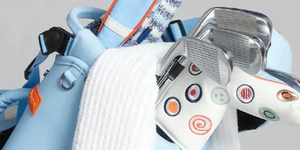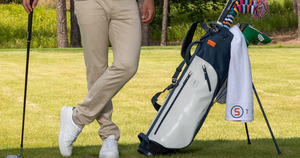How To Carry a Golf Bag The Correct Way
If you intend to walk your round rather than ride in a cart, then you could end up carrying your bag a very long way.
Carrying a golf bag incorrectly can lead to shoulder strain or back problems, the last thing you need if you want to ace your game.
How to carry a golf bag correctly will depend on the style of the bag and its type and size. Some golf bags are designed to sit on a buggy or pushcart to take the strain instead of you.
It is important to choose the right golf bag for your needs and not to overfill it. Different bags suit different people, so try out a few before buying.
Choosing the Right Golf Bag
A golf bag is second only in importance to your clubs, so making the right choice is critical.
There are three main types of golf bag.
The Golf Cart Bag
The golf cart bag is designed to attach securely to a golf cart.
The Golf Carry Bag
The golf carry bag is frequently combined with a stand so that when you arrive at the green, you don’t have to lie the bag down on the ground. This can also make it harder to access the right clubs.
Golf carry bags have either one or two shoulder straps, the latter rather like a rucksack.
Double straps are better for your back, provided the weight in the bag is evenly distributed, but it is more common to see single-strap options in use.
Many golf carry bags have a fitting to attach them to a standard pushcart, so if you fancy taking a bit of a rest, then it can be convenient to have this feature.
The Golf Stand Bag
Golf stand bags have a defined base or tripod to allow them to remain upright while you select your clubs and play.
Golf stand bags have the option of carrying straps and are sometimes compatible with buggies or push carts too.
Choose a design that offers even weight distribution. Some manufacturers offer this feature, and it is worth looking out for these brands.
Beware of many different pockets as the temptation is just to fill them…an extra jacket, some snacks, a water bottle in the thermal pocket, an umbrella, a spare pair of socks, it soon all adds up weight-wise.
It is always worth giving yourself the option of a strap to add your bag to a buggy or pushcart, as sometimes, if it is very hot or the weather is just difficult, no one wants the extra effort of carrying a heavy weight.
Loading a Golf Bag Properly
Loading your golf bag properly will significantly enhance your comfort and ease when you carry it.
Select the clubs you want for the course and load them, handles first so that the clubheads will be protruding outwards. Most golf bags have designated compartments and can accommodate up to 14 clubs.
Don’t take more clubs than you need.
Add your golf balls and tees to the side pockets, plus extras like your scorecard, cell phone, golf gloves, and a small towel.
A correctly packed golf bag is much easier to carry, particularly if you opt for a design with one strap and you have decided to shun the golf cart for your own two legs.
A lopsided weight will ultimately cause muscle strain and real pain, so try and ensure the items in the bag are as evenly distributed as possible.
Carrying a Golf Bag with One Strap
The accepted wisdom is to use your dominant shoulder if you have a design with a sole carry strap. Your dominant shoulder will be stronger, and you will suffer fewer ill effects.
Physiotherapists and personal trainers will tell you to keep swapping shoulders to even up both sides of your body. This applies to carrying any weight, not just a golf bag.
Swapping sides will give each one a break, and so you should find it less tiring to carry the bag for long distances.
Always adjust the strap to suit your height and frame when you buy a golf bag.
Carrying a Golf Bag with Two Straps
It is just as important to adjust the straps on a two-strap bag as with a design featuring a single strap.
The bag should sit quite high on your back. Look around you, and you will see lots of golfers who have too much slack in their bag straps. This will have a downward drag effect on your neck and back and is bad for your posture and game.
Pay Attention to the Quality and Type of Strap
Golf bag straps can be made from nylon or leather, often with reinforced pads or rubber grips. Most golf bags have a handle on the side, so you can pick the bag up and move it in addition to the shoulder strap.
Whether single or double, the straps should be soft molded and comfortable to wear. They should also be robust, durable, and wide enough to distribute pressure.
Practice Good Carrying Techniques
As with any heavy or awkward object or both, how you carry it is the real key to avoiding strains and sprains to parts of your body.
Two straps are generally considered better for the back and posture than one. The game can put quite enough strain on your body, as physical therapists will testify without adding to it with a poor carrying technique.
If you look around the course, you will see some classic examples of pretty bad posture. Stand tall with your shoulders rolled back and let your legs take the strain of carrying the bag, not your shoulders.
Slouched shoulders with the bodyweight forward over the base can damage the joints in the neck and spine over time.
If you can’t improve your posture, just carry less in your golf bag or ride in a buggy.
Ditch any Excess Weight
Try and avoid the mentality of ‘just in case’ club packing. Pack only the clubs you will really use and leave the rest behind. This will significantly lighten the load.
Clear out your golf bag regularly; you will be surprised at the unnecessary items lurking in different pockets.
Conclusion
Learning how to carry a golf bag correctly is no use if you have chosen the wrong design for your needs and it is poorly packed or just overloaded. Take time researching the style that will suit you best.
Never carry anything you don’t need to. Too many clubs can be more of a distraction than you might think – just take what you need.
Consider whether you want a style that can also be put on a pushcart or golf buggy – it’s a useful option to have, and there are plenty of occasions where you may be glad of the rest.
Most sports physicians and coaches would recommend using a design with double shoulder straps as less troublesome, but at the end of the day, this ultimately comes down to personal preference.



